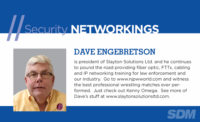
|
In some ways, things were better in the old days. Once I was young, working on the Illinois Tollway for $6 an hour (in 1972 that was really good money), gas was $0.39 a gallon, and I received retroactive back pay as a loyal member of Teamsters Local #705. Companies provided pensions to retirees, there were no terrorists, and there were no PCs in my house requiring security updates every week. Yeah, life was better then.
But there is one thing that is much better today than it was back in ’72 — the television viewing experience. Whereas once we were lucky to get three broadcast channels — and only if you were in a major market — now virtually everyone has access to hundreds of channels of content from available satellite dish systems and cable offerings. There is something for everyone, from cooking channels to fishing shows to classic TV series that we can automatically record for later viewing (“Combat!” at 3 a.m. on MeTV is a particular favorite). We can watch TV in high-definition (HD), download movies over the Internet, and watch Blu-ray DVDs.
Having had to purchase a new flat screen recently, I discovered that it is impossible to purchase a new television that doesn’t have HD capabilities. This is where the American public stands: 56 percent of American households have HD TVs (Nielsen Company research). And there are estimates from The Christian Science Monitor that up to 22 percent of U.S. Internet traffic between the hours of 6 p.m. and 12 midnight are movies being downloaded from Netflix. That’s a huge chunk of bandwidth, dwarfing all other services and applications on the Internet.
All of these entertainment video options fall into the class of “disruptive technologies,” which are devices or systems that really change the game for a particular service or industry. Think about PCs, Walkmans, Pac-Man games, and the record turntable that you either have never owned or has a quarter-inch of dust on top. New technologies come along at faster and faster intervals, upsetting business models and profitability for the old school companies, while boosting it for the new guys, at least until they get bought out.
What does this disruptive entertainment video mean to us in the electronic security business? The answer is that video and audio do work reliably over the Internet. This massive network also provides a viable pathway for remote control, alarm monitoring and cloud recording of surveillance video. Can 25.56 million Netflix subscribers (according to a Netflix press release, July 2011) be wrong? And if 25.56 million households will pay a monthly fee (RMR) to get the latest “Harry Potter” film, won’t they pay an RMR fee to be able to watch their office, home or vacation house over the Internet?
Besides the common usage of the Internet for downloaded video and audio, there’s another concept for security dealers to consider. End users are becoming accustomed to HD image quality on their television screens, and they will expect the same from their security cameras. After watching HD on a 6-foot flat screen, is viewing a barely-in-focus 640 x 480 VGA security camera image going to make them happy?
Your clients are going to want to see similar quality in their security video that they are getting from their home entertainment systems, because that is what they are getting used to. And they will want their security video available at will from their TV, PC, handheld, smartphone — whatever type of device that has a display screen and is Internet-connected.
So what technology is available now that will provide the image quality and IP flexibility that the new breed of customers will want? HD IP security cameras are here today, and available from a host of quality vendors. Get a demonstration from your local equipment representative (or come to one of my classes) and see it for yourself. While these cameras are not the cheapest, the technically savvy end user may well want the higher end HD cameras.
Bob Dylan is 70 years old, gasoline is nearly $4 a gallon, and many of our cities and states are nearly bankrupt — but we’ve got great home TV viewing. George Orwell would be proud of us. But the times are a changin’, and great opportunities exist for those dealers who believe that presenting high-quality HD video to their clients now will make a positive difference in their sales and customer satisfaction.






